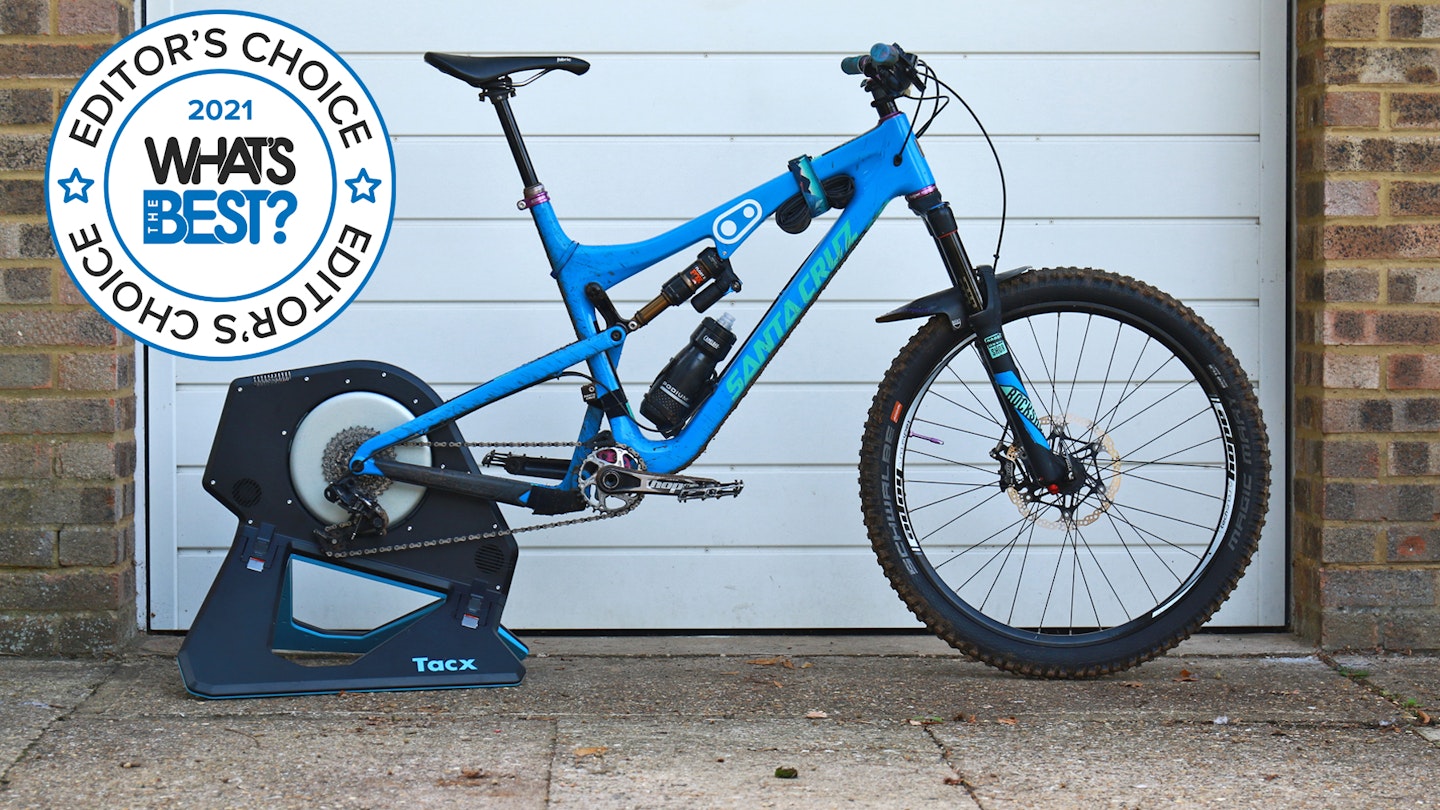When cycling indoors was a simple case of attaching your biketo a turboor rollers and clocking up the miles, it was very simple. Then smart training came along, with its array of sensors, power meters and apps, and the whole arrangement became infinitely more measurable and complex.
The Tacx Neo 2T offers all the performance-enhancing benefits of linking up to Zwiftor TrainerRoad with none of the faff – you take it out of the box, put your bike on it and go. But is that simplicity and ease of use enough to justify its cost? What’s The Best’s Adam Binnie is back in lycra (again, not photographed) to find out.
| Specifications | |
|---|---|
| Type | Magnetic turbo trainer |
| Max power | 2,200W |
| Max gradient | 25% |
| Power source | Three-pin/not needed |
| Flywheel | 125kg (simulated) |
| Fits | 9/12mm axles, 130-148mm wide |
| Kit includes | Neo 2T, front wheel support, quick release skewer, axle adaptors, power supply |
| Pros | Cons |
|---|---|
| • Ease of use | • Expensive |
| • No need to calibrate | • No carrying handle |
| • Fits all bikes | • No cassette included |
Verdict: I’ll be honest, I liked the results of indoor training but didn’t enjoy the actual process before the Neo 2T. My previous set-up (a dumb turbo with separate sensors) was inaccurate and prone to going wrong, which often gave me the ideal excuse to avoid getting off my backside and going for a ride.
This Tacx trainer is totally plug and play and always ready to go, doesn’t require a spare rear wheel with a special tyre, and best of all needs zero calibration to keep it working. In its normal mode it feels just like riding up and down a real hill, which makes it immersive enough to hold my attention, and in the ERG setting it gives you the exact resistance your training ride calls for without the need to mess around changing gears.
If it had a carrying handle it’d be perfect - without one it’s just very, very, very good.
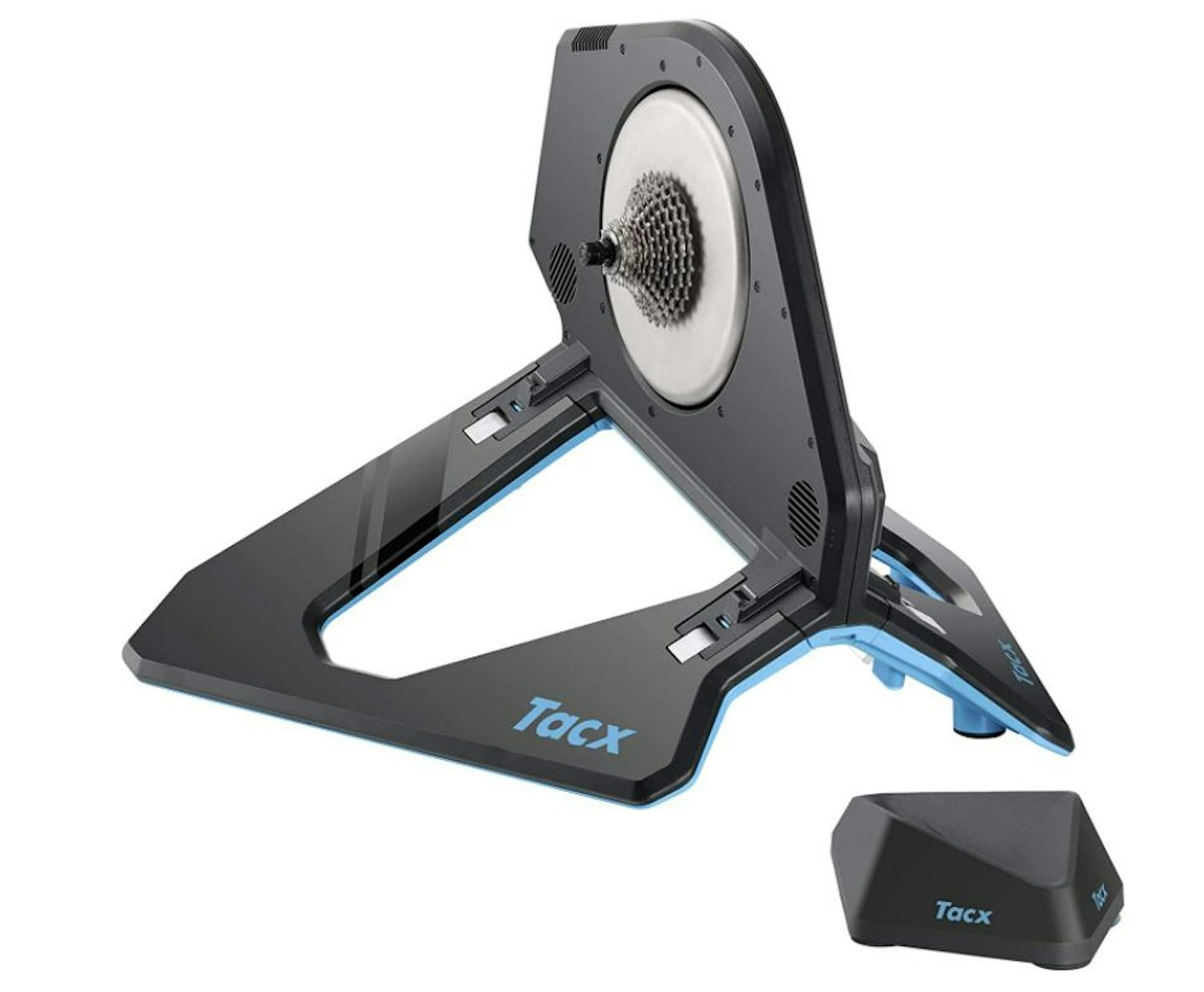
www.garmin.com
Build
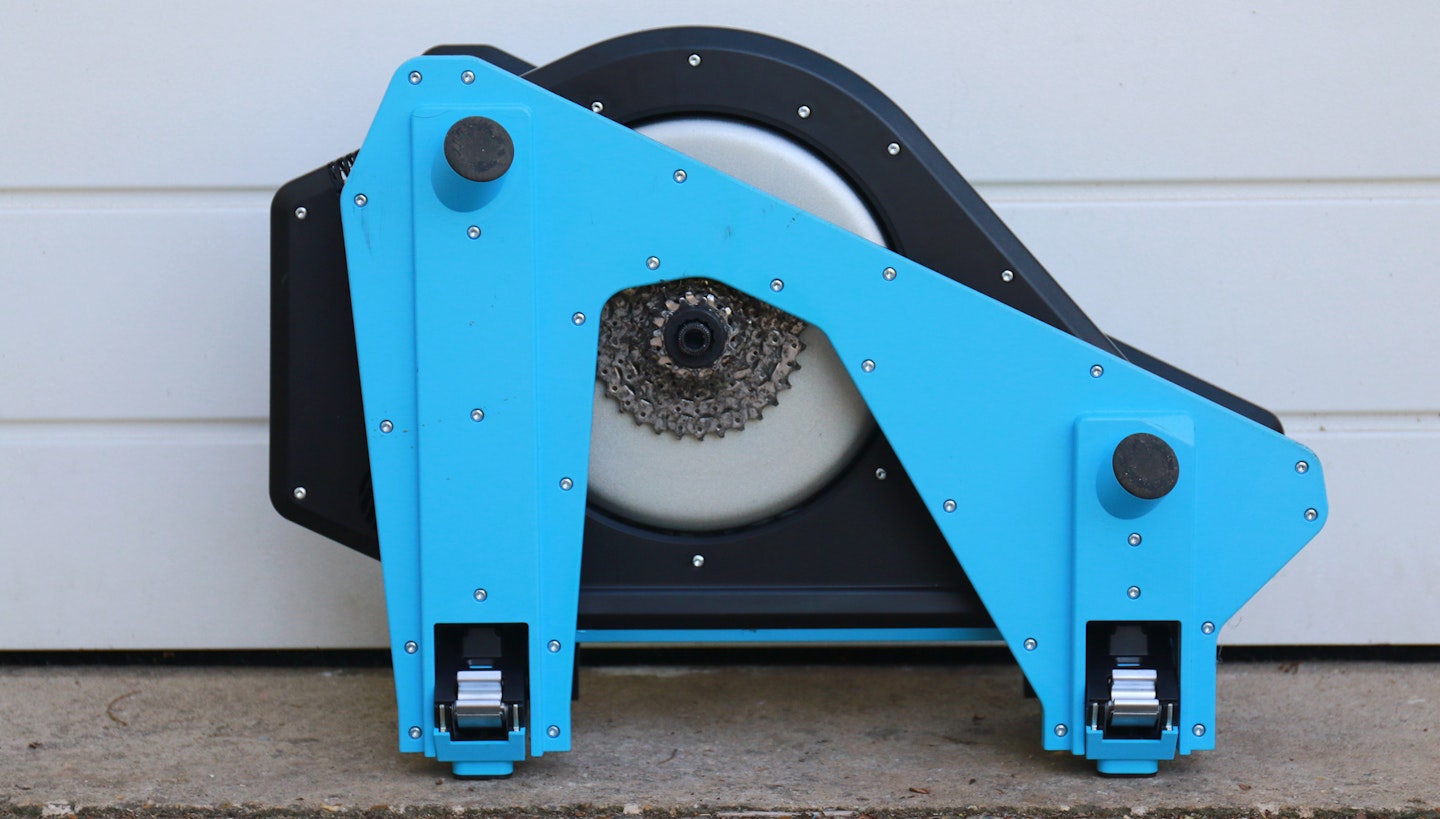
• Strong, wide base for stability
• Solid construction
• Plastic picks up knocks and scrapes
Compared to the Tacx Boost I recently reviewed the setup process for the Neo 2T is incredibly easy, because it comes 99% built and there’s no need to get the gap between the motor and the rear tyre just right, because the trainer attaches directly to your bike. You also don’t need to attach fiddly sensorsto the rear hub and pedal crank because the unit calculates your wattage output and cadence. Genuine plug and play.
The sides of the trainer fold up vertically for storage (where it takes up a surprisingly small amount of space) and click into place when you want to use it again. It’s very stable when set up but allows a bit of side-to-side motion, especially when you’re standing up and sprinting, but this helps with the overall sensation of recreating road feel.
Assembly is as simple as taking it out of the box, attaching your chosen gearing (you will need to provide a cassette) and then screwing in an adaptor either side of the unit depending on what rear axle your bike has. Then you’re good to go.

Out of the box this trainer will fit both 9mm quick release and 12mm axles, in widths from 130mm up to 148mm. This means both my 2012 road bike and 2018 mountain bike slotted straight on - an impressive range, all things considered.
Gearing-wise if you have a 9-11 speed Shimano or Sram cassette then it will fit just fine, but you’ll need a separate adaptor if you want to use anything Campagnolo or 12 speed XDR/Microspline. My mountain bike has a Hope cassette which did not fit, but I had an old 10-speed Sram lying around, and that was fine.
Basically the Neo 2T will suit the vast majority of drivetrain set ups without having to adapt - you 12-speeders will need to budget for a different freehub and at the moment there’s no way to hook up a
157mm Super Boot mountain bike. But then again, would you really want to?
My only complaint here is that at 21.5kg the Neo 2T is not a light unit (although this does aid stability) and there’s nowhere obvious to grab hold of it when moving it around, so I’ve dropped it a couple of times when folding up the legs.
This is compounded by the other issue – the matte black plastic finish looks great but is slippery to hold and picks up scratches easily, either from my metal mountain bike SPD cleats or from the aforementioned clumsiness. A handle on top would sort this right out, but there isn’t one, and this is annoying.
Usability
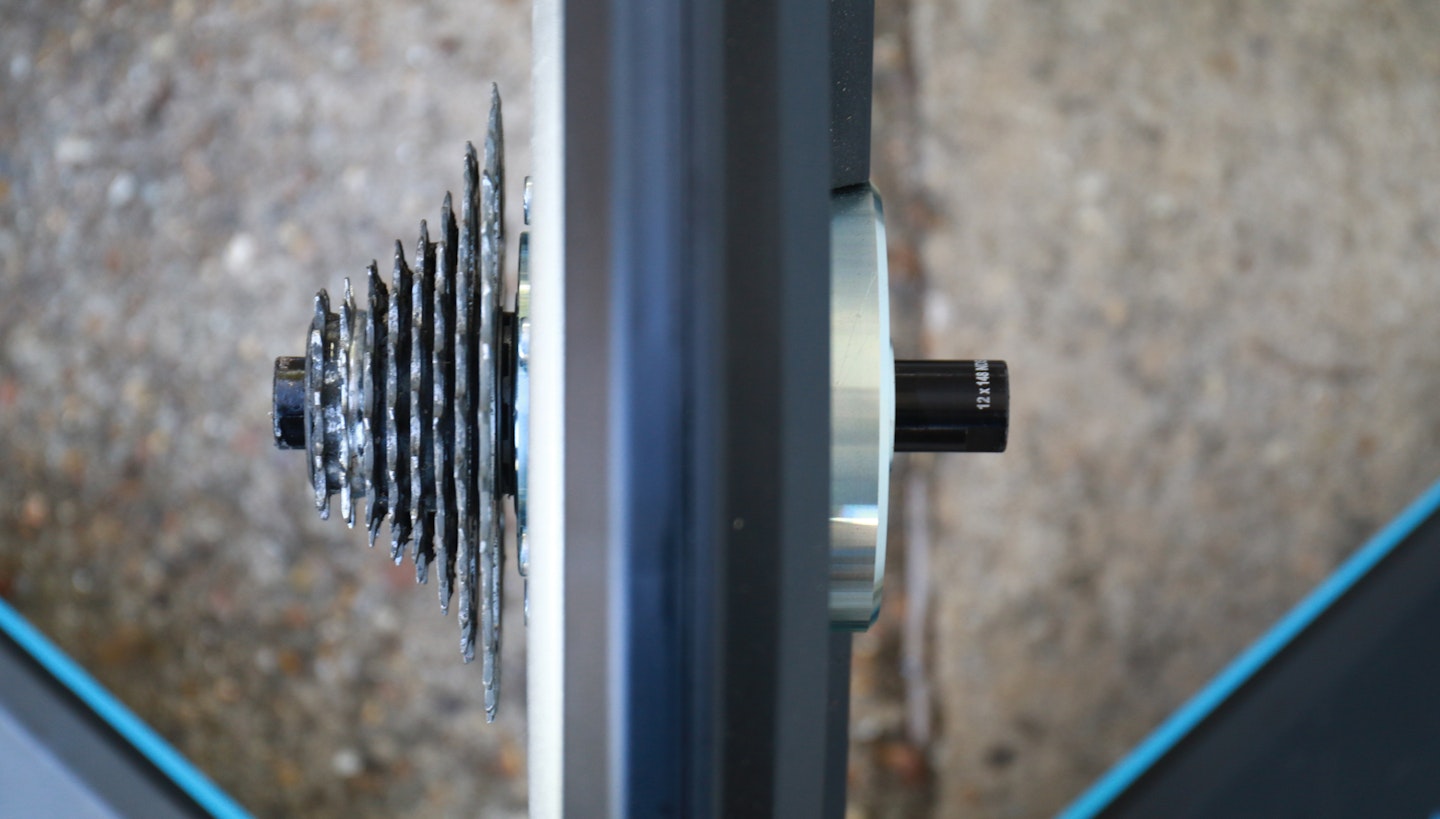
• Power supply not essential
• No additional sensors required
• Doesn’t need regular calibration
As with all turbos though the way to get the best out of the Neo 2T is to leave it set up with a dedicated bike, preferably on a Tacx-branded training mat in an immaculate tiled training studio like they have on the advert. In the real world you’re likely to be in a garage or shed, and ideally near a three-pin plug.
The Neo 2T needs power to get the best from it but unlike rivals it’s not actually essential – you can run it just fine without a socket, which means it’s portable and can be taken to bike events for pre-race warmups or simply used at the bottom of the garden with no outdoor power.
Do so and you miss out on simulated freewheeling – if you stop pedalling while going down a hill the unit keeps turning, making you feel like you’re really descending and enabling a break for your legs. Unplugged the Neo 2T spins down quickly and you need to pedal hard to get it back up to speed. You also need outside power for the Real Road Feel feature, which vibrates the unit when you’re riding over cobbles or a dirt track, for example. This is fun and adds another layer of realism, but not essential.
Connecting to training apps is easy with either ANT+ or Bluetooth compatibility. I use Zwift on my phone and it’s a simple case of selecting the Neo 2T from the controllable menu and then going for a ride. In my previous set up there was quite often a problem with either the speed or cadence sensor (or both) and I’d have to spend a few minutes getting frustrated trying to get them to hook up to my phone.
You also get a wheel chock in the box to secure the front end of your bike and raise it up to be level with the rear and this works with my skinny road bike and a 2.35-inch dirt tyre.
Performance
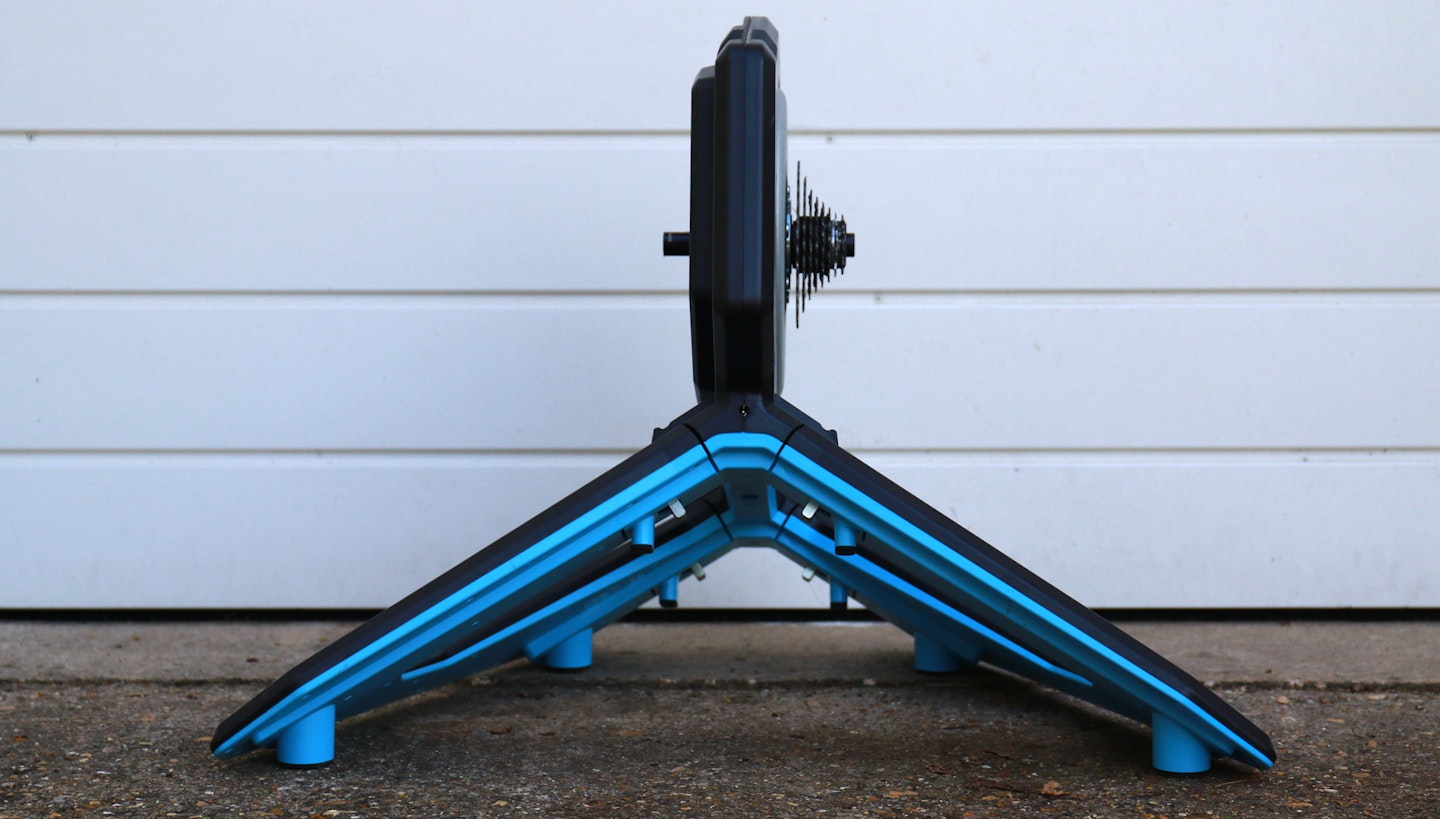
• Very, very quiet
• Huge power levels
• Can simulate steep hills
For anyone less than superhuman the Neo 2T has all the right numbers – it can provide up to 2,200W of resistance, which should be enough for even the punchiest of sprinters, and can simulate inclines of 25% gradient. At which point I’d be fitting my massive mountain bike gearing.
Tacx says it can deliver this within 1% accuracy, which I wasn’t able to verify as I don’t have power meter pedals or cranks, and this is one of the best features for casual users like me. I could never be sure whether my old analogue trainer was set up properly, and in fact when I took my training bike out on the actual road, it felt significantly harder to get up to speed. The Neo 2T feels exactly like riding on the road for real.
Part of that is the smoothness of the resistance change – when you encounter a hill on the screen, the resistance in the trainer builds up as if it would do on the road, and you have to change gears in order to keep on top of it.
The other way to use the Neo 2T is in ERG mode, which is particularly useful when following a training plan that calls for intervals of specific cadence and power output. On my old trainer if my next interval called for 100rpm and 200 watts, for example, I’d have to get my pedal speed right and then shift the gears around until I was putting out the required power (or as close to it as possible).
On this unit you leave your bike in any gear you want (I choose a different one at the start of every ride to spread out the wear) and the trainer adjusts the resistance to match. All you have to worry about is your cadence, so you can focus entirely on the effort. This is not unique to Tacx but it is brilliant, and a bit of a game-changer for me.
Hook up to a third-party app and the Neo 2T can provide information on your pedalling, which foot produces more power and the like, and there’s a Tacx app with workouts if you don’t want to use Zwift or Trainer Road. You can also use this to update the device’s firmware, something I had to do when ERG mode started malfunctioning and giving me way too much resistance during training rides. Ten minutes later the Neo 2T had downloaded the new software wirelessly from my phone and was good to go.
In terms of long-term use there’s nothing you need to do in order to keep the Neo 2T working – other smart direct drive turbos use heavy flywheels connected with belts and these need calibrating every now and then. The Tacx’s magnet system just works all the time.
Price

Yes – this is the slightly awkward part, because the Neo 2T is rather pricey. At this point it’s a choice between the Tacx and the Wahoo Kickr, which is slightly cheaper and comes with a cassette. Numbers-wise it’s broadly similar although can only simulate a 20% gradient, which is still very steep.
That said though, it’s still cheaper than Peloton (providing you already have a real bike to hook up to it) and enables year-round training from the comfort of your home. And I reckon I’ve used it two or three times as much as my old non-smart turbo just because it’s so immersive and fun to ride on, even carrying on with indoor training during the summer as a means of keeping fit for real rides outside.
{#h-}
Verdict

www.garmin.com
• All the performance you need
• Fun and easy to use
• Looks great
This is the smart direct drive turbo trainer to go for, so the only question is whether you can justify the price. For me, the fact that I now look forward to my every-other-day indoor spin means it's easy to recommend.
| Pros | Cons |
|---|---|
| • Ease of use | • Expensive |
| • No need to calibrate | • No carrying handle |
| • Fits all bikes | • No cassette included |
